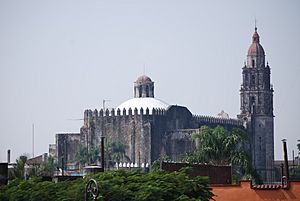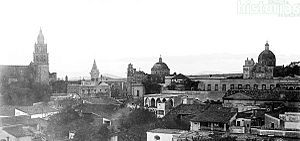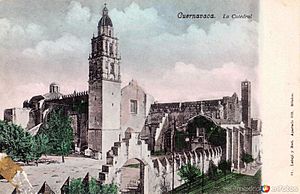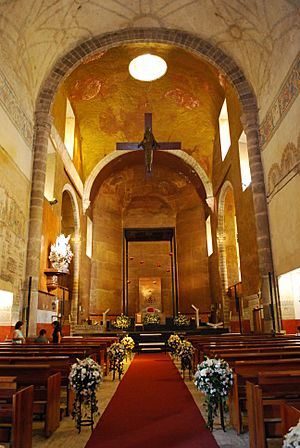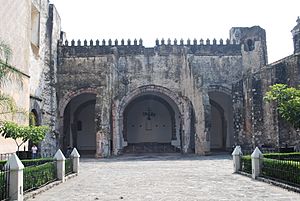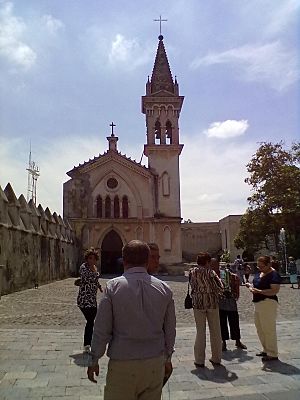Cuernavaca Cathedral facts for kids
Quick facts for kids Cathedral of the Assumption of MaryCatedral de la Asunción de María |
|
|---|---|
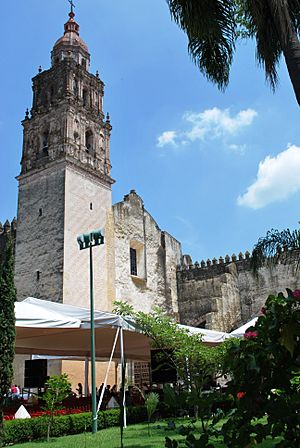
Facade and belltower of the cathedral
|
|
| Religion | |
| Affiliation | Roman Catholic |
| Province | Diocese of Cuernavaca |
| Rite | Roman Rite |
| Ecclesiastical or organizational status | cathedral |
| Leadership | Bis. Alfonso Cortés Contreras |
| Year consecrated | 16th century |
| Location | |
| Location | Cuernavaca, Mexico |
| Architecture | |
| Architectural type | church |
| Architectural style | Baroque |
| Groundbreaking | 1529 |
| Completed | 1534 |
| Specifications | |
| Length | 80 metres (260 ft) |
| Width | 40 metres (130 ft) |
| Spire(s) | 1 |
| Official name: Earliest 16th century monasteries on the slopes of Popocatépetl | |
| Type | Cultural |
| Criteria | ii, iv |
| Designated | 1994 |
| Reference no. | 702 |
| State Party | |
| Region | Latin America and the Caribbean |
The Cuernavaca Cathedral (in Spanish, Catedral de la Asunción de María) is a very old Roman Catholic church in Cuernavaca, Mexico. It is the main church for the Diocese of Cuernavaca.
This church and its surrounding monastery are part of a special group. They are among the first monasteries built in the 1500s near the Popocatepetl volcano. UNESCO has named them a World Heritage Site. They were built to help teach Christianity to the local people after the Spanish conquest of the Aztec Empire.
Over time, the monastery church became the main church for the city. In the late 1800s, it became a cathedral. Unlike many cathedrals in Mexico, it is not on the main city square. Instead, it is in its own walled area with other buildings. The cathedral has been updated several times, with the last big changes happening in 1957. During this work, a large 17th-century mural was found. It covers about 400 square meters and tells the story of Philip of Jesus and 23 other missionaries who were crucified in Japan.
Contents
History of the Cathedral
The Cuernavaca Cathedral was once part of the Monastery of the Assumption of Mary. This monastery was one of many strong, fortress-like monasteries built in the early 1500s. They were located near the Popocatepetl volcano. These buildings helped Spanish missionaries teach Christianity to the native people after the Spanish arrived.
The Franciscans, a group of monks, started the monastery in 1525. Their main goal was to teach the local people about Christianity. They also trained missionaries to go to other parts of New Spain. At first, only Spanish people and important native leaders could enter the main church and its walled courtyard.
Building the complex began in 1529 on land given by Hernán Cortés's wife, Juana de Zúñiga de Cortés. It was the fifth building project by the Franciscan order in New Spain. Like other monasteries of that time, it had tall, thick walls and defensive features. This was to protect the missionaries from local people who were still hostile. The monastery's land was much larger back then. It included big gardens where the monks grew food and other supplies.
The complex was built in different stages and changed over the centuries. An engraving from 1532 is at the north entrance, but the facade was likely finished by 1574. By the late 1600s, most of the main church was complete.
However, only the outer walls of the main church and the ground floor arches of the cloister remain from the very first construction. This is because the church was remodeled many times. It was very important for spreading Christianity and later as a city church and then a cathedral. Among the fourteen early monasteries recognized by UNESCO, this is the only one that has changed a lot since it was built.
In the 1600s, two chapels were added to the church, giving it a cross shape. The choir area and side altars were probably added then too. In 1713, a dome-like vault and a bell tower were added. These new parts were in the Baroque style, which is known for its fancy decorations. A clock, originally made for the Segovia Cathedral, is at the base of the tower. It was given to Hernán Cortés by King Charles V in the 1500s.
By the mid-1700s, the church's inside was richly decorated with religious art, including items made of silver. Around this time, the monastery's main church also started serving as the main parish church for Cuernavaca.
The monastery buildings stayed the same until the late 1800s. During the Reform War in Mexico, many monasteries were closed. The La Asuncion de Maria monastery lost most of its land and buildings. One building that used to be part of the complex is now the Robert Brady Museum. In 1882, an earthquake damaged the top of the tower, which was later rebuilt.
In 1891, Pope Leo XIII created the Roman Catholic Diocese of Cuernavaca. The Parish of Nuestra Señora de la Asunción became the Cuernavaca Cathedral. The first bishop was Fortino Hipólito Vera. In the early 1900s, during the Mexican Revolution, part of the complex was used as a headquarters by General Pablo González Garza.
By the mid-1900s, the church still had some of its old, rich decorations. This included a main altar with gold details and two side altars. However, in 1957, the cathedral had a big renovation by the government. Some parts, like the cloister's cells and library, were restored to their original look. Baroque elements were added to the bell tower.
The biggest changes were inside the main church. Old plaster was removed, revealing a mural from the 1700s. This mural covers almost all the walls of the main nave. It tells the story of the martyrdom of Philip of Jesus and other missionaries in Nagasaki. The old altars and decorations were mostly removed and replaced with simple, modern ones. The older items were put in an art storage room on the premises, but they are not open to the public.
In 1994, the cathedral complex became part of the Monasteries on the slopes of Popocatépetl World Heritage Site.
What the Cathedral Looks Like
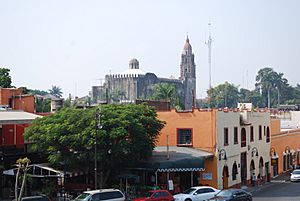
The cathedral complex is in the historic center of Cuernavaca. It is not on the main city square, but just south of it. The complex has a walled area with the main church, a cloister (a covered walkway), and several chapels. The main church and cloister are in the northeast part. The other chapels are on the sides or corners, forming an L-shaped courtyard. This layout is similar to how it was first built, though it is a bit smaller now. The complex was built away from the city center to give a sense of peace and quiet.
The courtyard used to be a cemetery. Today, it has trees and paths connecting the different buildings. In the middle of the courtyard is a stone cross on a base. Some experts believe the base was once a "cuauhxicalli", a stone used for ancient rituals. Using it as a base for the cross was meant to show the triumph of Christianity. The cross itself is made from a single piece of sandstone. The courtyard also has a monument to "certain Spaniards who were murdered."
On the west side of the complex, next to the main church and cloister, is the capilla abierta (open chapel). This was one of the first buildings the Spanish built after Hernán Cortés chose Cuernavaca as his base. The open chapel was once larger than it is today. It was used for Mass, plays, music, and dances. These events helped explain and strengthen the Christian faith. The chapel's roof is held up by large arches. It also serves as a covered entrance to the cloister. Today, the cloister is used as offices for the bishop. It was restored in the 1900s and has two levels around a central courtyard. The cloister still has some old paintings, some showing missionaries in the Philippines and Japan.
The main church has a simple front. The only part with fancy decoration is the bell tower, which also has a clock. Just inside the main entrance, there is a bronze statue of Jesus carrying a cross. Beyond that is a very large stone baptismal font. Inside, the church is mostly plain and modern, especially near the main altar. A cross with an image of Christ hangs over the altar. Small modern crosses are on the side walls.
However, the most important decoration is a large mural from the 1700s. This mural was found during the renovation in the mid-1900s. It covers 400 square meters of both side walls in the church's main area. It tells the story of Philip of Jesus and other missionaries who were killed in Japan. The mural was likely painted in the mid-1600s. It was painted using the fresco method, which means painting on wet plaster. We don't know much about who painted it or why it was created. One expert thinks an artist from Asia, helped by local people, painted it. Another believes it was purely a local work. Philip of Jesus was the first Mexican saint, and a Franciscan, so his story was important to this monastery. This mural was covered in the 1800s and forgotten until it was rediscovered in the 1900s.
The mural's story begins with Pope Innocence II blessing the 23 missionaries. They arrived in Japan from the Philippines. There are scenes of the 16 Japanese and five Spanish missionaries working in Kyoto. Then, it shows them in caged carts, guarded by soldiers, being taken to Nagasaki. The 24th martyr is Philip of Jesus, who was shipwrecked in Japan. The emperor of Japan, Toyotomi Hideyoshi, offered to spare his life because he had not preached Christianity. But Philip refused and was crucified with the others. For this, he became a saint. A legend says that on the day he died, a fig tree in his family's orchards in Mexico came back to life.
The complex also has a pinacotheca, which is an art storage room. It holds old artifacts, paintings, and other artworks from the 1500s to the 1800s. This collection was started by Francisco Plancarte y Navarrete, the second bishop of Cuernavaca. His personal collection of ancient artifacts and rare religious art became part of a museum. More religious objects and tapestries were added over time.
By 1987, this collection was not stored in the best conditions. Efforts by Juan Dubernard Chavenau and a Mexican project called "Adopt a Work of Art" convinced the INAH (Mexico's National Institute of Anthropology and History) to build better facilities. They also helped restore 58 religious paintings. One important series of paintings is called the "Apostolado," which shows each of the Apostles. This is one of only three such groups of paintings in Mexico. Other paintings include "Estigmatización de San Francisco de Asís" from the 1500s, which shows Saint Francis receiving the stigmata. There are also "La natividad de Ia Virgen María" and “San Francisco Javier” from the 1600s, “La última cena” from the 1700s, and "Jesús calma Ia tormenta" by Rafael Flores from the 1800s.
The Chapels
The most important chapel in the complex is the capilla abierta (open chapel), dedicated to Saint Joseph. This type of open chapel was common in Mexico in the early 1500s. They were used for Mass and other religious activities to help convert the native population. It is possible that Hernán Cortés had this chapel built. To build it, workers from many villages around Cuernavaca were brought in. Unlike many other open chapels, this one is parallel to the main church, not at a right angle. This design was unique in Mexico and Spain. It also serves as the portico (entrance) to the cloister, which was the first of its kind in Mexico. The chapel was damaged in an earthquake in 1882. Inside, above the cloister entrance, there is a mural called "Spiritual lineage of Saint Francis of Assisi". It shows the life of the Franciscan order's founder and the saints it produced. This mural is now in poor condition. Today, the open chapel is often used for weddings.
The next important chapel is the Tercera Orden Chapel (Chapel of the Third Order). It was built in the northwest corner of the complex in 1722. Later, a seminary (a school for priests) was added to it. This seminary became a very important school in Cuernavaca in the 1800s. This chapel was built in a style called popular Baroque, with some Churriguersque elements. The front has sculptures of angels and saints, some with native headdresses. The bell tower has two levels but is not very tall. The entrance on the south side has a seashell shape at the top. Inside, it has a Latin cross shape with one main area, divided into an upper choir, nave, and apse. The main altar is Baroque, richly decorated with colorful flowers, angels, and saints. This altar was made by native craftspeople.
The other two large chapels on the site are the Nuestra Señora de los Dolores Chapel and the Santa Cruz Chapel. The first one is one of the oldest buildings in the complex, built before the main church. The Santa Cruz Chapel is in the Neogothic style and honors Our Lady of Mount Carmel.
Museum of Religious Art
The Museo de Arte Sacro (Museum of Religious Art) opened on July 12, 2018. Its entrance is in the southwest corner of the church complex. The museum cost about $2 million US dollars to build. It holds 92 paintings, sculptures, priestly clothes, and other items from the 1500s to the 2000s.
The first room is about Catholic worship. It includes La Diosa Tonantzin, a fertility goddess statue found under the main altar. It also has priestly clothes and other religious objects and paintings. The second room is about St. Francis of Assisi. It includes Estigmatización de San Francisco (Stigmatization of San Francisco) by Andrés de la Concha from the late 1500s. The third room tells about how Christianity spread in Mexico, focusing on Our Lady of Guadalupe. El Señor de Chalma con Florones (Lord of Chalma with Rosettes) and La Resurrección de Cristo (The Resurrection of Christ), believed to be by José de Ibarra from the 1700s, are here. Juan Correa is represented by El Nacimiento de la Virgen (Birth of the Virgin) and La Educación de la Virgen (Education of the Virgin). Simon Pereyns is represented by La Crucifixión (The Crucifixion). There is an entrance fee to visit the museum.
See also
 In Spanish: Catedral de Cuernavaca para niños
In Spanish: Catedral de Cuernavaca para niños


